Ground Risk Estimation of Unmanned Aerial Vehicles Based on Probability Approximation for Impact Positions with Multi-Uncertainties
Abstract
:1. Introduction
2. Problem Description
3. Modeling for Ground Safety Assessment
3.1. Estimation of Horizontally Travelled Distance
3.1.1. Kinematic Pattern of UAV’s Descent
3.1.2. Three Stages from UAV Failure to Ground Impact
3.1.3. Estimation of Horizontally Travelled Distance
3.2. Derivations of Ground Features
3.2.1. Casualty Area of UAV’s Debris
3.2.2. Probability of Fatal Injuries
3.2.3. Calculation of UAV’s Kinetic Energy at Impact Point
3.2.4. Sheltering Factors on the Ground
3.2.5. Uncertainties Caused by Wind
3.3. Modeling for Safety Assessment and Risk Estimation
4. Simulations and Verification
4.1. Simulation Scenario
4.2. UAV Parameter Settings
4.3. Horizontally Travelled Distance with Dual Uncertainties
4.4. Possible Impact Positions with Three Uncertainties
4.5. Ground Safety Assessment with Multi-Uncertainties
4.5.1. Casualties on the Ground with Different Flight Directions
4.5.2. Casualties on the Ground with Different Wind Speeds
4.5.3. Casualties on the Ground with Different Wind Directions
4.5.4. Casualties on the Ground with Different Flying Heights
5. Conclusions
Author Contributions
Funding
Data Availability Statement
Conflicts of Interest
References
- Clothier, R.A.; Williams, B.P.; Hayhurst, K.J. Modelling the risks remotely piloted aircraft pose to people on the ground. Saf. Sci. 2018, 101, 33–47. [Google Scholar] [CrossRef] [PubMed]
- Yang, J.; Huang, X. Intelligent Planning Modeling and Optimization of UAV Cluster Based on Multi-Objective Optimization Algorithm. Electronics 2022, 11, 4238. [Google Scholar] [CrossRef]
- Yang, L.; Zhang, X.; Zhang, Y.; Xiangmin, G. Collision Free 4D Path Planning for Multiple UAVs Based on Spatial Refined Voting Mechanism and PSO Approach. Chin. J. Aeronaut. 2019, 32, 1504–1519. [Google Scholar]
- Zhang, R.; Dou, L.; Wang, Q.; Xin, B.; Ding, Y. Ability-Restricted Indoor Reconnaissance Task Planning for Multiple UAVs. Electronics 2022, 11, 4227. [Google Scholar] [CrossRef]
- Clothier, R.A.; Palmer, J.L.; Walker, R.A.; Fulton, N.L. Definition of an airworthiness certification framework for civil unmanned aircraft systems. Saf. Sci. 2011, 49, 871–885. [Google Scholar] [CrossRef]
- Liu, Y.; Zhang, X.; Guan, X.; Delahaye, D. Potential Odor Intensity Grid Based UAV Path Planning Algorithm with Particle Swarm Optimization Approach. Math. Probl. Eng. 2016, 2016, 7802798. [Google Scholar] [CrossRef]
- Washington, A.; Clothier, R.A.; Silva, J. A review of unmanned aircraft system ground risk models. Prog. Aerosp. Sci. 2017, 95, 24–44. [Google Scholar] [CrossRef]
- EASA. Concept of Operations for Drones A Risk Based Approach to Regulation of Unmanned Aircraft; EASA Brochure: Cologne, Germany, 2015. [Google Scholar]
- Lazatin, J. A Method for Risk Estimation Analysis for Unmanned Aerial System Operation over Populated Areas. In Proceedings of the 14th AIAA Aviation Technology, Integration, and Operations (ATIO) Conference, American Institute of Aeronautics and Astronautics, Atlanta, GA, USA, 16–20 June 2014. [Google Scholar]
- Lum, C.; Waggoner, B. A Risk Based Paradigm and Model for Unmanned Aerial Systems in the National Airspace. In Proceedings of the Infotech@Aerospace Conferences, American Institute of Aeronautics and Astronautics, Louis, MO, USA, 29–31 March 2011. [Google Scholar]
- Aalmoes, R.; Cheung, Y.S.; Sunil, E.; Hoekstra, J.M.; Bussink, F. A Conceptual Third Party Risk Model for Personal and Unmanned Aerial Vehicles. In Proceedings of the 2015 International Conference on Unmanned Aircraft Systems (ICUAS), Denver, CO, USA, 9–12 June 2015; pp. 1301–1309. [Google Scholar]
- Clothier, R.A.; Palmer, J.L.; Walker, R.A.; Fulton, N.L. Definition of Airworthiness Categories for Civil Unmanned Aircraft Systems (UAS). In Proceedings of the 27th International Congress of the Aeronautical Sciences, ICAS, Nice, France, 19–24 September 2010. [Google Scholar]
- Lum, C.; Gauksheim, K.; Deseure, C.; Vagners, J.; McGeer, T. Assessing and Estimating Risk of Operating Unmanned Aerial Systems in Populated Areas. In Proceedings of the 11th Aviation Technology, Integration, and Operations (ATIO) Conference, American Institute of Aeronautics and Astronautics, Virginia Beach, VA, USA, 20–22 September 2011. [Google Scholar]
- Ford, A.; McEntee, K. Assessment of the Risk to Ground Population Due to an Unmanned Aircraft In-Flight Failure. In Proceedings of the 10th AIAA Aviation Technology, Integration, and Operations (ATIO) Conference, American Institute of Aeronautics and Astronautics, Fort Worth, TX, USA, 13–15 September 2010. [Google Scholar]
- Weibel, R.; Hansman, R.J. Safety Considerations for Operation of Different Classes of UAVs in the NAS. In Proceedings of the 4th Aviation Technology, Integration and Operations (ATIO) Conference, American Institute of Aeronautics and Astronautics, Chicago, IL, USA, 20–22 September 2004. [Google Scholar]
- Burke, D.A.; Hall, C.E.; Cook, S.P. System-Level Airworthiness Tool. J. Aircr. 2011, 48, 777–785. [Google Scholar] [CrossRef]
- Melnyk, R.; Schrage, D.; Volovoi, V.; Jimenez, H. A Third-Party Casualty Risk Model for Unmanned Aircraft System Operations. Reliab. Eng. Syst. Saf. 2014, 124, 105–116. [Google Scholar] [CrossRef]
- Courharbo, A.L. Ground impact probability distribution for small unmanned aircraft in ballistic descent. In In Proceedings of the 2020 International Conference on Unmanned Aircraft Systems (ICUAS), Athens, Greece, 1–4 September 2020. [Google Scholar]
- Courharbo, A.L. Quantifying risk of ground impact fatalities of power line inspection BVLOS flight with small unmanned aircraft. In Proceedings of the 2017 International Conference on Unmanned Aircraft Systems (ICUAS), Miami, FL, USA, 13–16 June 2017; pp. 1352–1360. [Google Scholar]
- Zhang, X.; Liu, Y.; Zhang, Y.; Guan, X.; Delahaye, D.; Tang, L. Safety Assessment and Risk Estimation for Unmanned Aerial Vehicles Operating in National Airspace System. J. Adv. Transp. 2018, 2018, 4731585. [Google Scholar] [CrossRef]
- Smith, P.G. Expected Casualty Calculations For Commercial Space Launch and Reentry Missions-Advisory Circular; Technical Report; Federal Aviation Administration: Washington, DC, USA, 2000. [Google Scholar]
- Dalamagkidis, K.; Valavanis, K.P.; Piegl, L.A. On Integrating Unmanned Aircraft Systems into the National Airspace System: Issues, Challenges, Operational Restrictions, Certification, and Recommendations; Springer Science & Business Media: Berlin/Heidelberg, Germany, 2011. [Google Scholar]
- Wilde, P. Common Risk Criteria Standards for National Test Ranges; Technical Report; Range Commanders Council: White Sands Missile Range, NM, USA, 2017. [Google Scholar]
- Guglieri, G.; Quagliotti, F.; Ristorto, G. Operational issues and assessment of risk for light UAVs. J. Unmanned Veh. Syst. 2014, 2, 119–129. [Google Scholar] [CrossRef]
- Scott, D.W. Kernel Density Estimation. Wiley StatsRef: Statistics Reference Online. 15 February 2018. Available online: https://doi.org/10.1002/9781118445112.stat07186.pub2 (accessed on 18 December 2022). [CrossRef]
- Botev, Z.I.; Grotowski, J.F.; Kroese, D.P. Kernel Density Estimation via Diffusion. Ann. Stat. 2010, 38, 2916–2957. [Google Scholar] [CrossRef]
- Chen, Y.C. A Tutorial on Kernel Density Estimation and Recent Advances. Biostat. Epidemiol. 2017, 1, 161–187. [Google Scholar] [CrossRef]
- Gramacki, A. Nonparametric Kernel Density Estimation and Its Computational Aspects; Springer International Publishing: Cham, Switzerland, 2018. [Google Scholar]

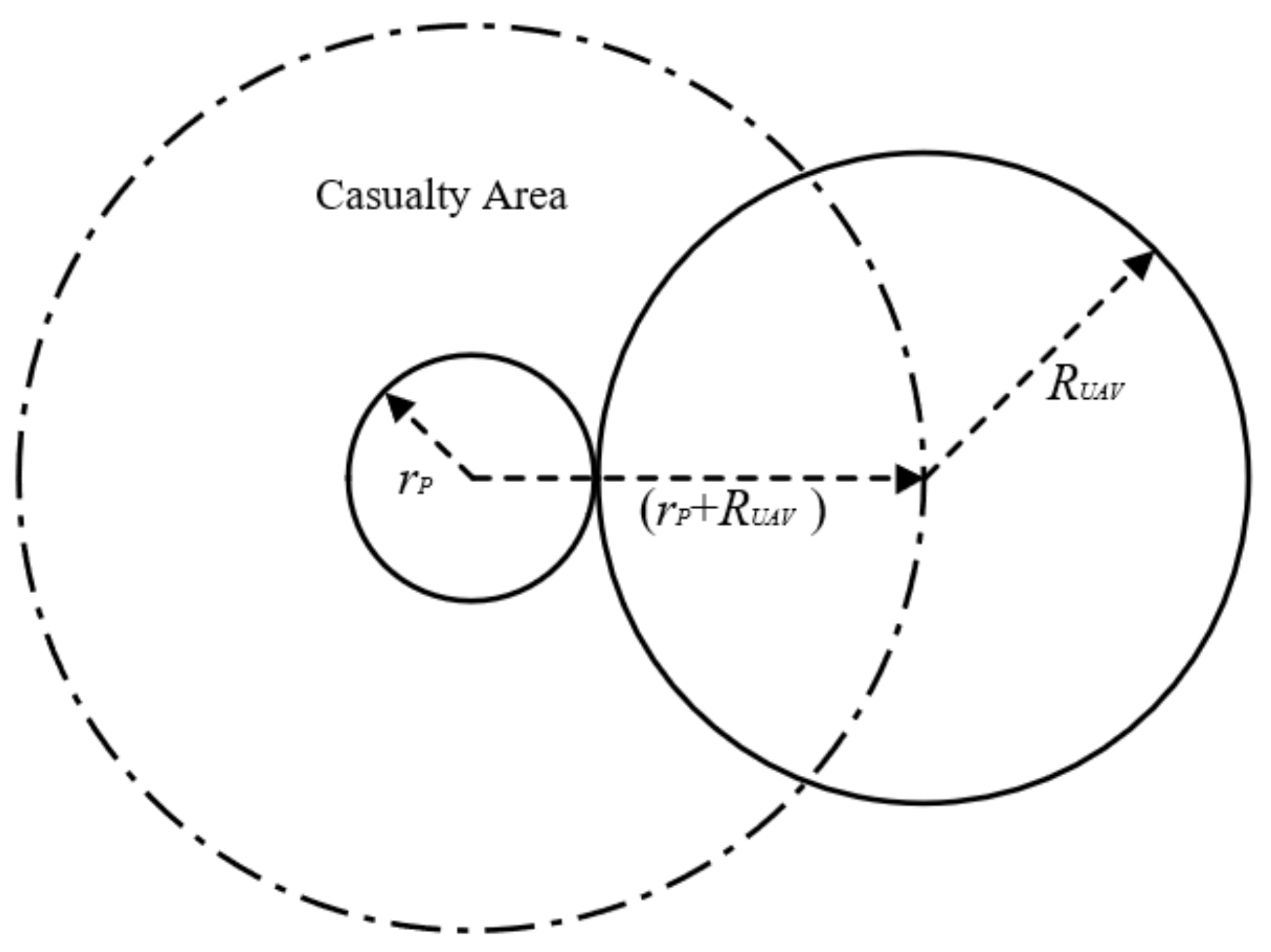
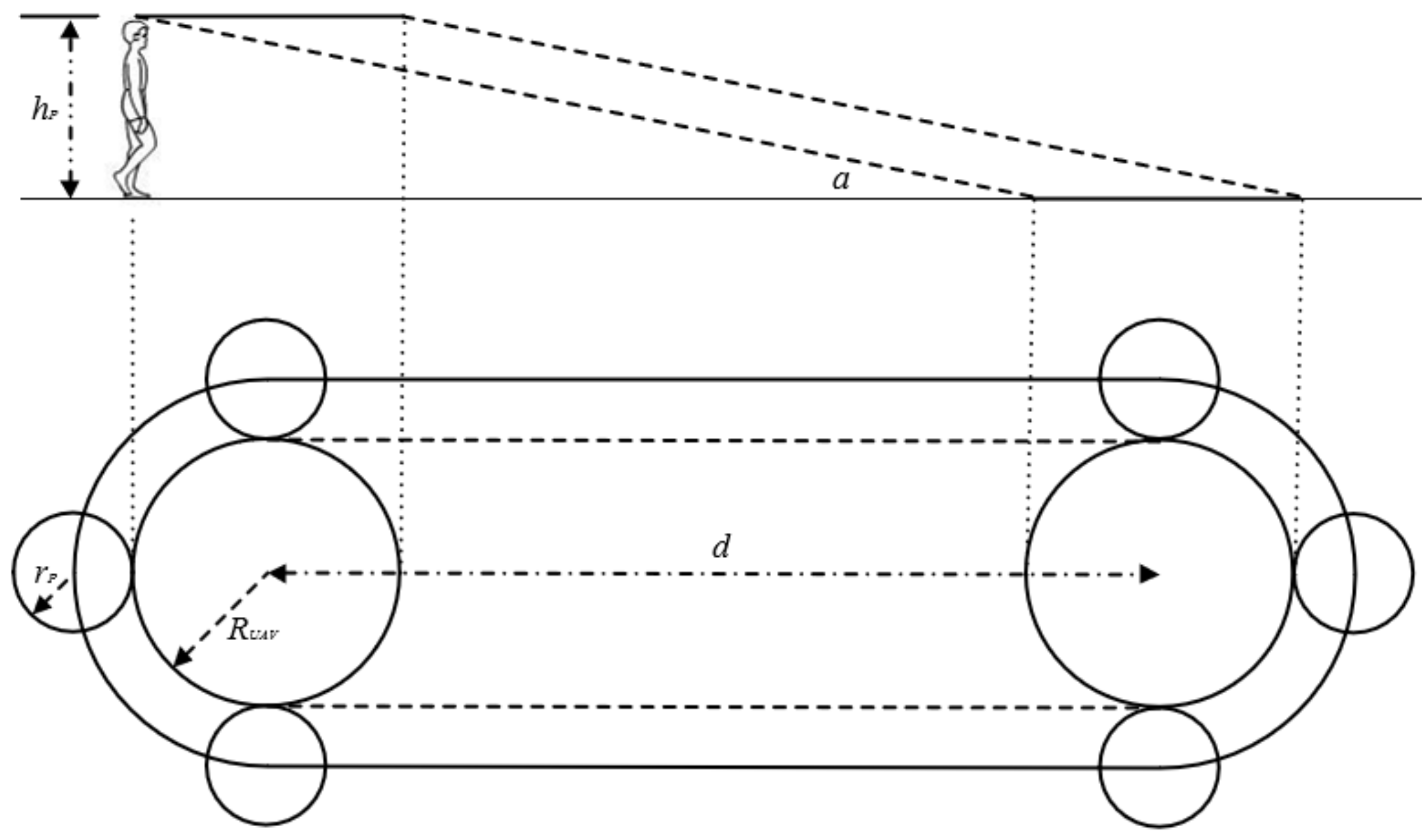

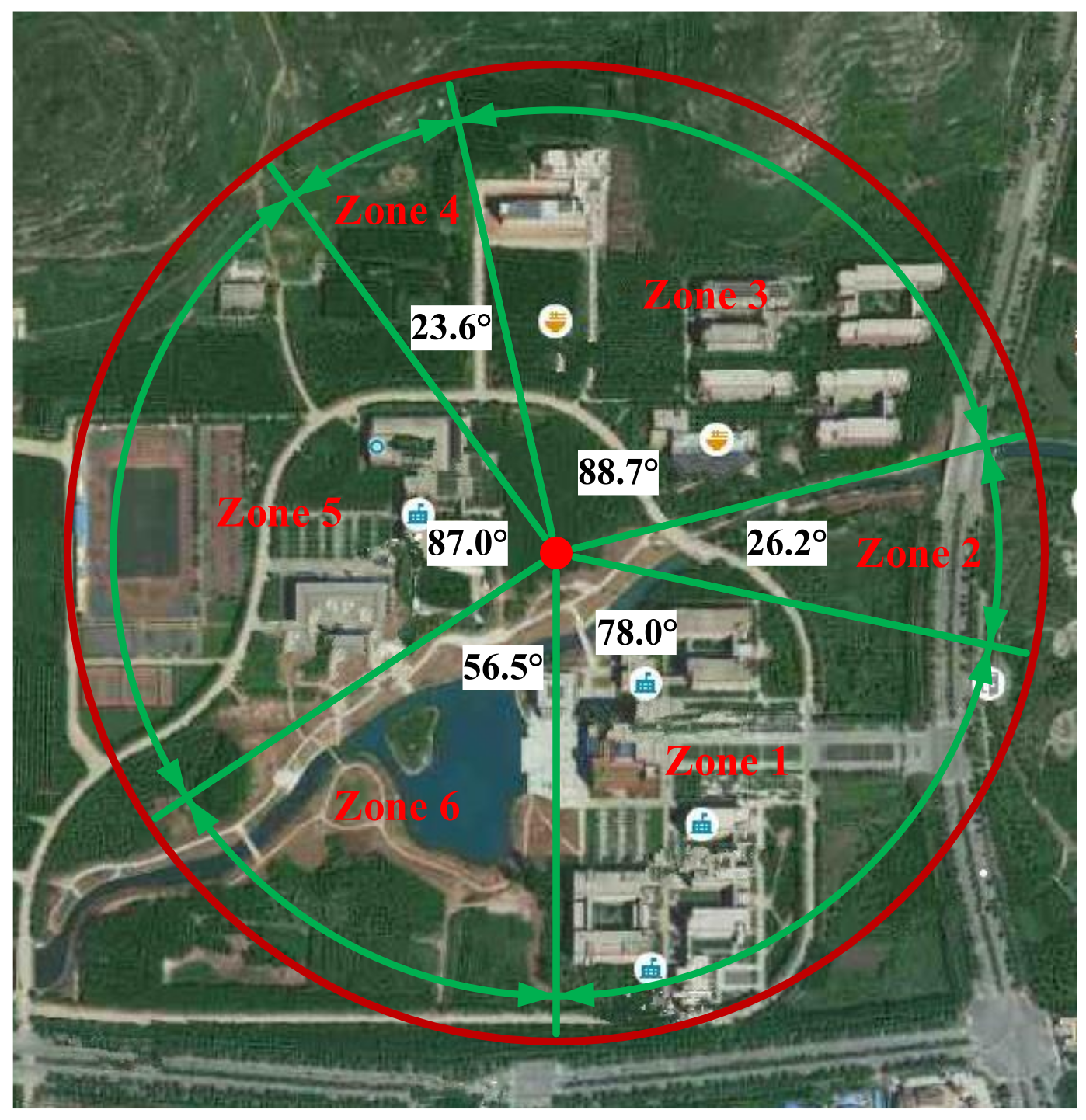

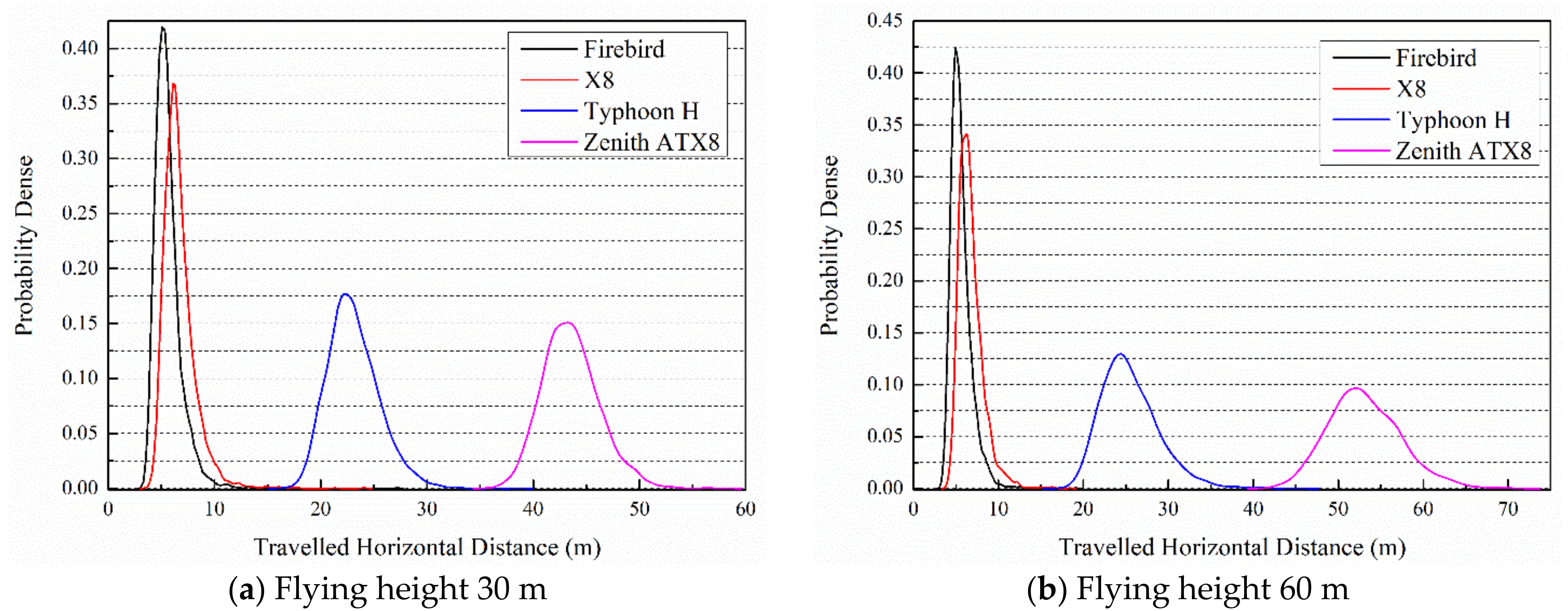

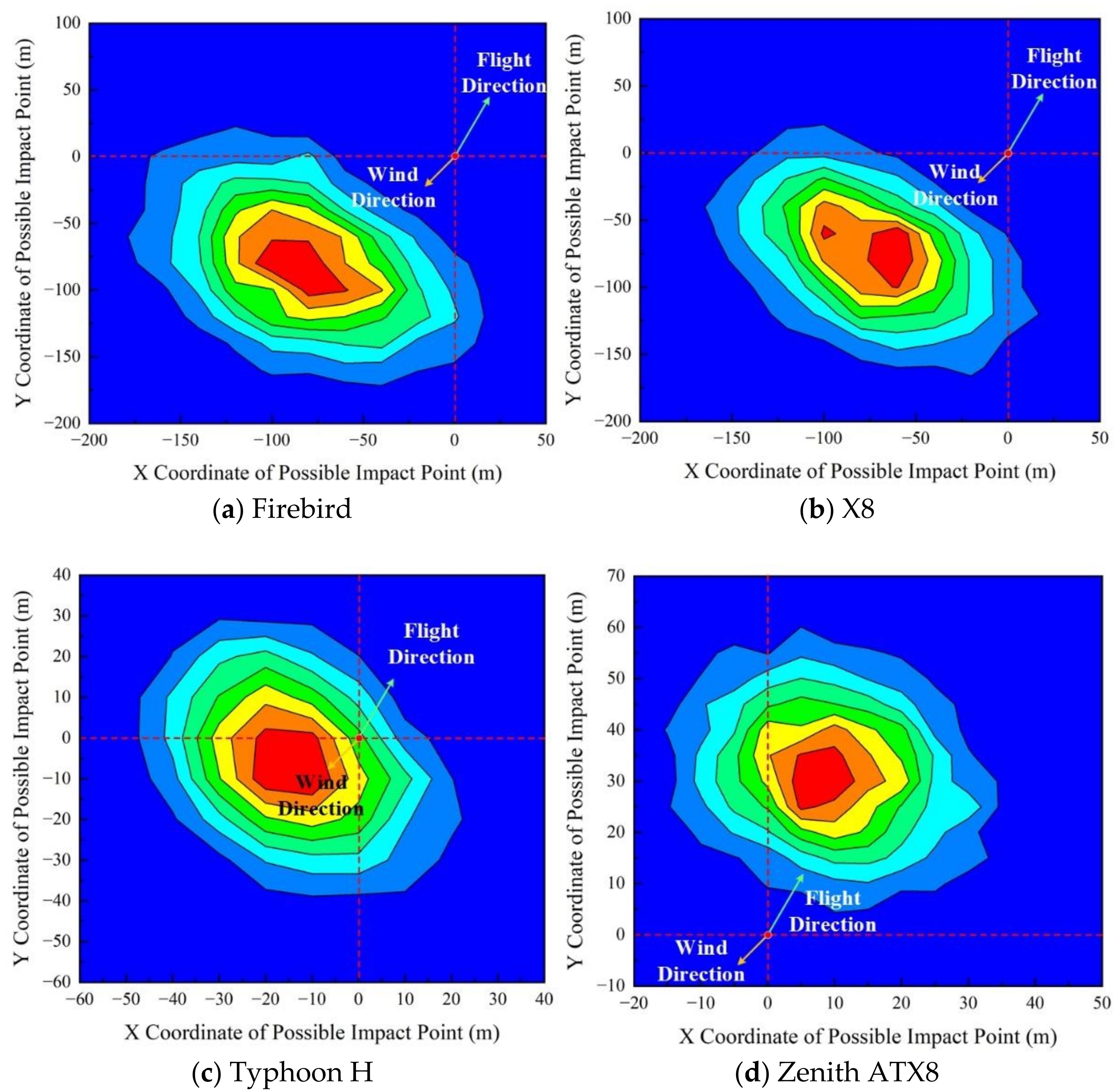
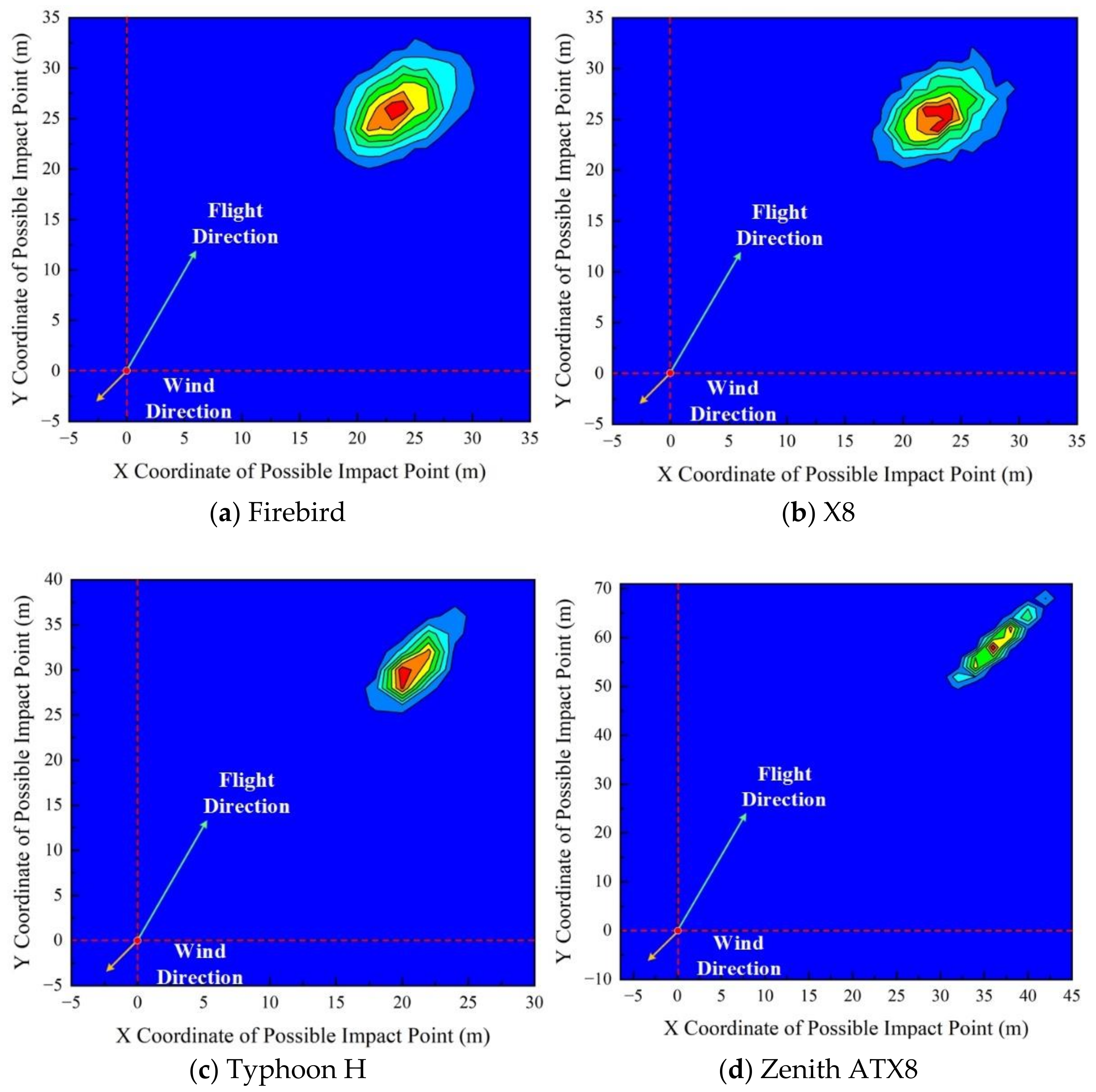
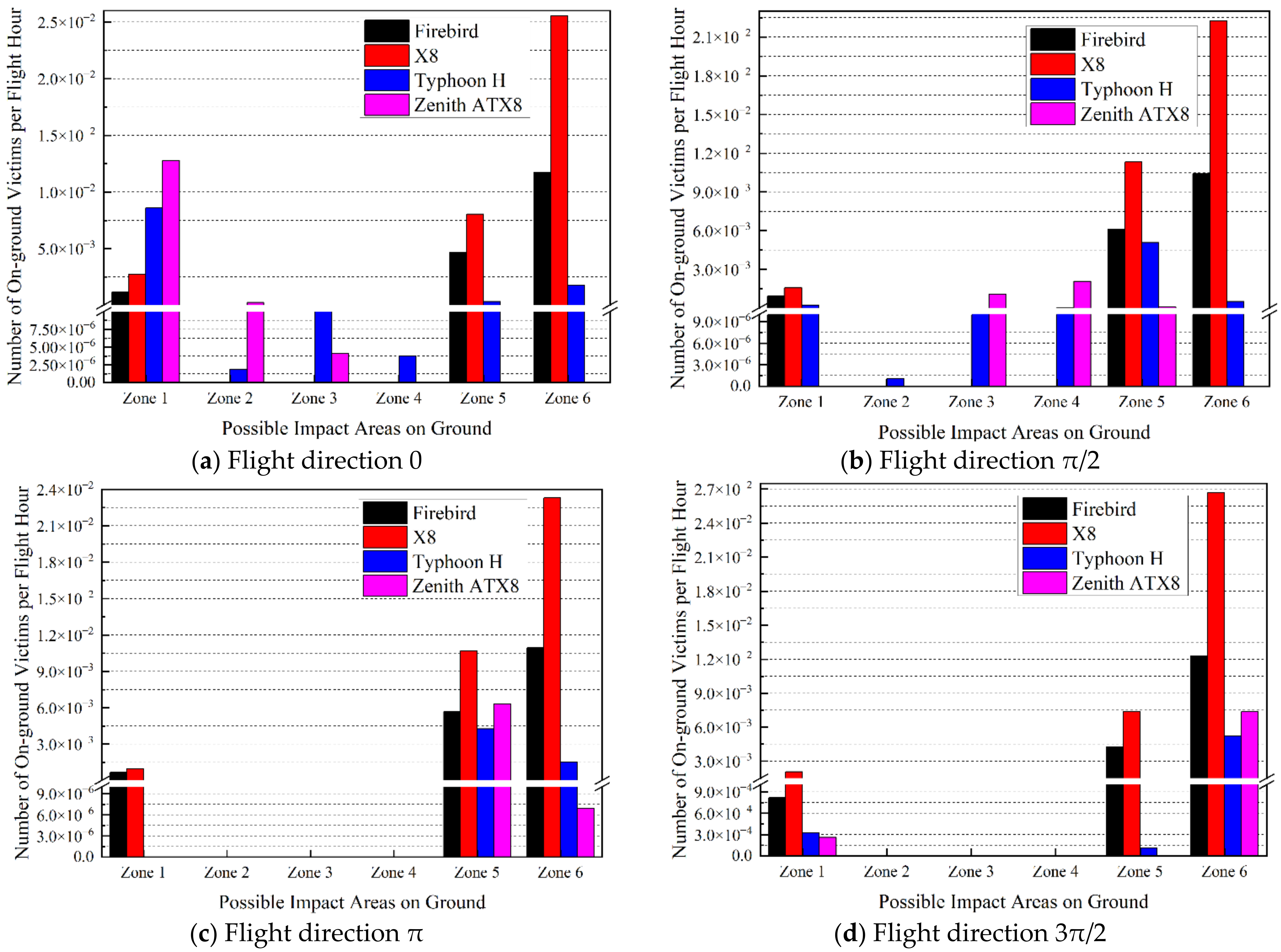
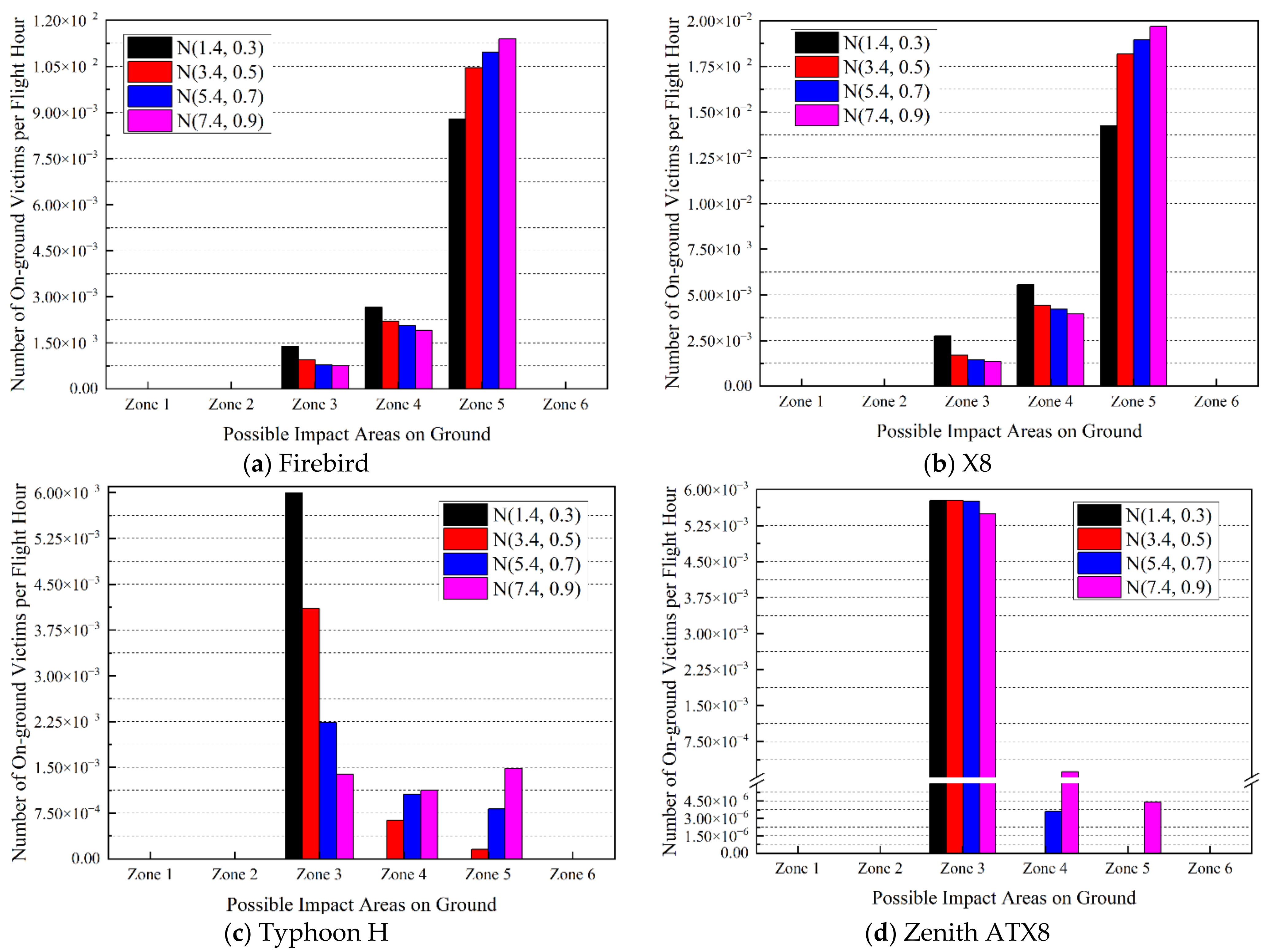

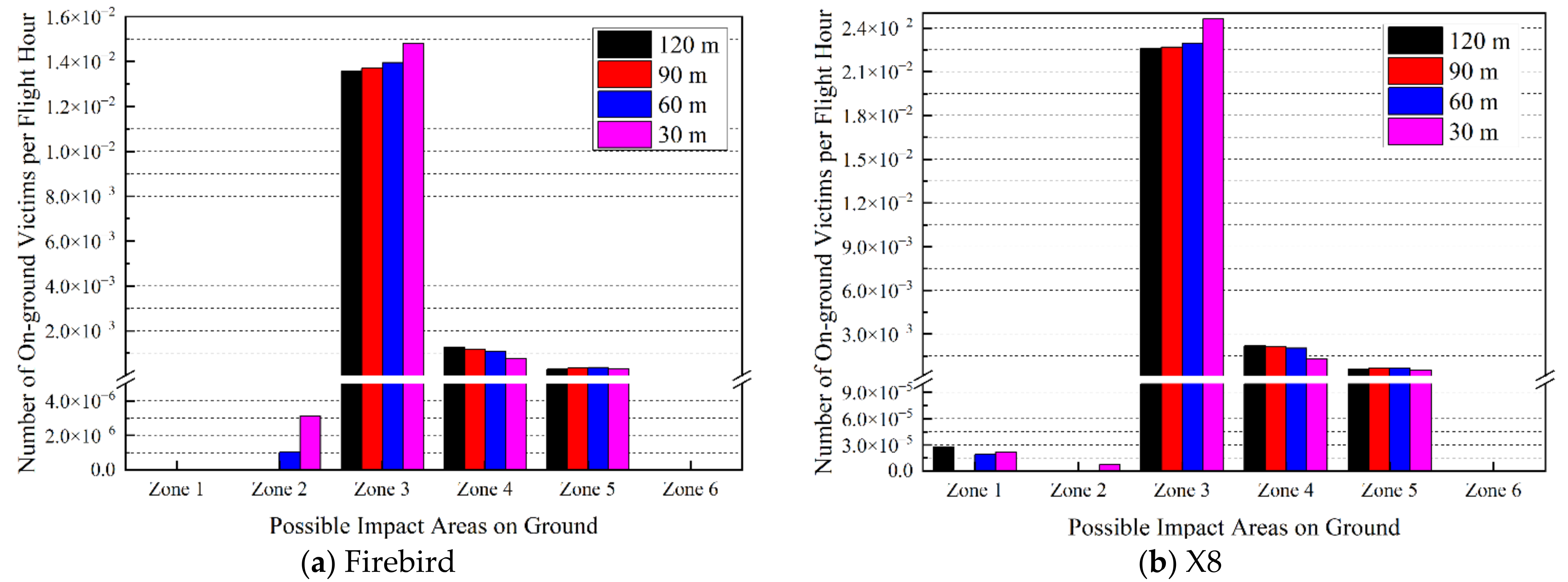
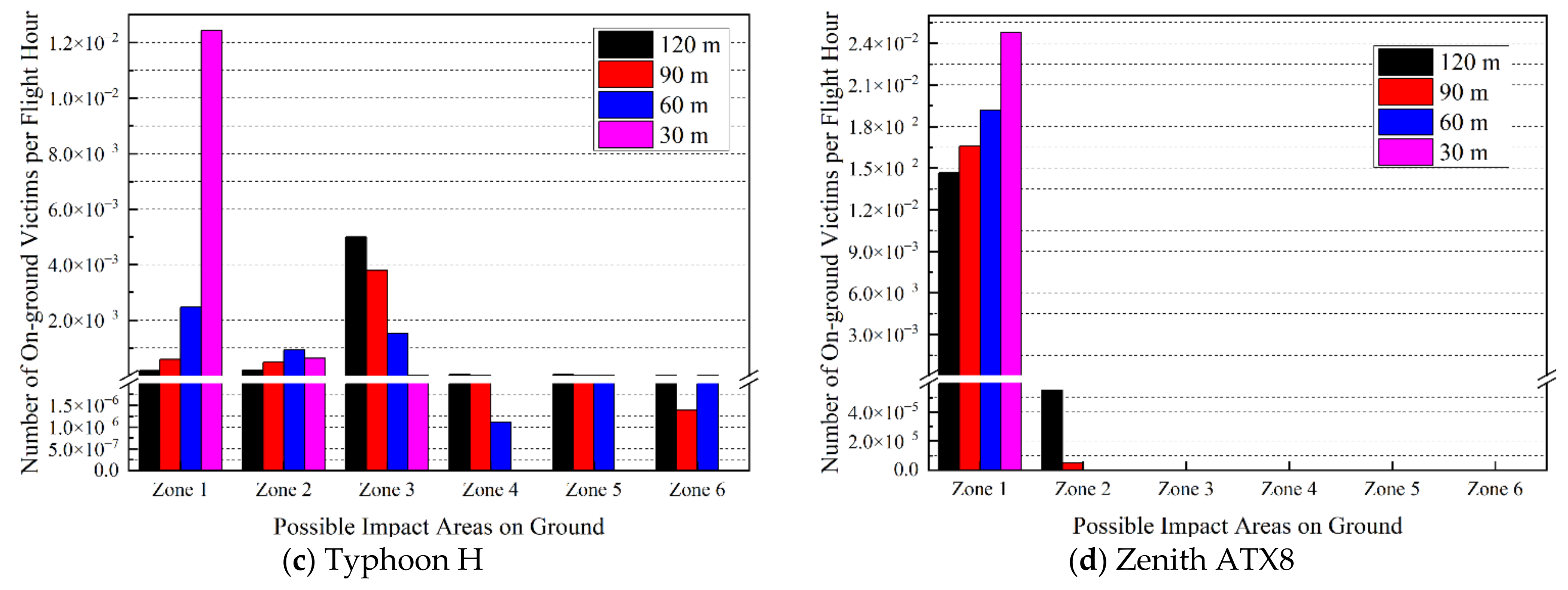
| Type No. | Area | Sheltering Factor |
|---|---|---|
| Type 1 | Reinforced concrete buildings | 40 |
| Type 2 | Trees | 20 |
| Type 3 | Sparse trees | 10 |
| Type 4 | Area without obstacles | 0 |
| Zone No. | Buildings | Trees | Sparse Trees | No Obstacles | Central Angle |
|---|---|---|---|---|---|
| Zone 1 | 17.32% | 21.37% | 23.74% | 37.57% | 78.0° |
| Zone 2 | 0 | 58.32% | 32.39% | 9.29% | 26.2° |
| Zone 3 | 27.27% | 49.69% | 5.81% | 17.23% | 88.7° |
| Zone 4 | 0 | 41.95% | 21.10% | 36.95% | 23.6° |
| Zone 5 | 11.14% | 46.45% | 6.68% | 35.73% | 87.0° |
| Zone 6 | 0 | 7.69% | 62.03% | 30.28% | 56.5° |
| Zone No. | Central Angle | Population | Percentage |
|---|---|---|---|
| Zone 1 | 78 | 10,534 | 40% |
| Zone 2 | 26.2 | 395 | 1.5% |
| Zone 3 | 88.7 | 7901 | 30% |
| Zone 4 | 23.6 | 395 | 1.5% |
| Zone 5 | 87 | 5267 | 20% |
| Zone 6 | 56.5 | 1843 | 7% |
| Type | Model | Wingspan | Length | MTOM | Speed |
|---|---|---|---|---|---|
| Fixed | Firebird | 1200 mm | 830 mm | 1.2 kg | 83 km/h |
| X8 | 2120 mm | 820 mm | 4.2 kg | 110 km/h | |
| Rotary | Typhoon H | 457 mm | 520 mm | 1.98 kg | 48.6 km/h |
| Zenith ATX8 | 600 mm | 600 mm | 9.65 kg | 72 km/h |
| Variables | Firebird | X8 | Typhoon H | ATX8 |
|---|---|---|---|---|
| Initial horizontal speed | N (23.1, 0.2) m/s | N (30.6, 0.2) m/s | N (13.5, 0.2) m/s | N (20, 0.2) m/s |
| Initial vertical speed | N (−5, 0.2) m/s | |||
| Drag coefficient | N (0.9, 0.2) | |||
| Number of samples | 4000 | |||
| Variables | Values | |
|---|---|---|
| Flight direction | π/3 | |
| Wind direction | N (5π/4, π/8) | N (π/4, π/40) |
| Wind speed (m/s) | N (5, 1) | N (1, 0.1) |
| Variables | Values | |||
|---|---|---|---|---|
| Flight direction | 0 | π/2 | π | 3π/2 |
| Wind direction | N (5π/4, π/8) | |||
| Wind speed (m/s) | N (3.4, 0.5) | |||
| Variables | Values | |||
|---|---|---|---|---|
| Wind speed | N (1.4, 0.3) | N (3.4, 0.5) | N (5.4, 0.7) | N (7.4, 0.9) |
| Wind direction | N (3π/4, π/10) | |||
| Flight direction | π/4 | |||
| Variables | Values | |||
|---|---|---|---|---|
| Wind direction | N (π/4, π/8) | N (3π/4, π/8) | N (5π/4, π/8) | N (7π/4, π/8) |
| Wind speed | N (3.4, 0.5) | |||
| Flight direction | π/4 | |||
| Variables | Values | |||
|---|---|---|---|---|
| Flying heights | 120 m | 90 m | 60 m | 30 m |
| Wind direction | N (π/2, π/10) | |||
| Wind speed | N (3.4, 0.5) | |||
| Flight direction | −π/4 | |||
Disclaimer/Publisher’s Note: The statements, opinions and data contained in all publications are solely those of the individual author(s) and contributor(s) and not of MDPI and/or the editor(s). MDPI and/or the editor(s) disclaim responsibility for any injury to people or property resulting from any ideas, methods, instructions or products referred to in the content. |
© 2023 by the authors. Licensee MDPI, Basel, Switzerland. This article is an open access article distributed under the terms and conditions of the Creative Commons Attribution (CC BY) license (https://creativecommons.org/licenses/by/4.0/).
Share and Cite
Liu, Y.; Zhu, Y.; Wang, Z.; Zhang, X.; Li, Y. Ground Risk Estimation of Unmanned Aerial Vehicles Based on Probability Approximation for Impact Positions with Multi-Uncertainties. Electronics 2023, 12, 829. https://doi.org/10.3390/electronics12040829
Liu Y, Zhu Y, Wang Z, Zhang X, Li Y. Ground Risk Estimation of Unmanned Aerial Vehicles Based on Probability Approximation for Impact Positions with Multi-Uncertainties. Electronics. 2023; 12(4):829. https://doi.org/10.3390/electronics12040829
Chicago/Turabian StyleLiu, Yang, Yuanjun Zhu, Zhi Wang, Xuejun Zhang, and Yan Li. 2023. "Ground Risk Estimation of Unmanned Aerial Vehicles Based on Probability Approximation for Impact Positions with Multi-Uncertainties" Electronics 12, no. 4: 829. https://doi.org/10.3390/electronics12040829





